« Features
Seeing Life Through Roberto Fabelo’s Visionary Eyes
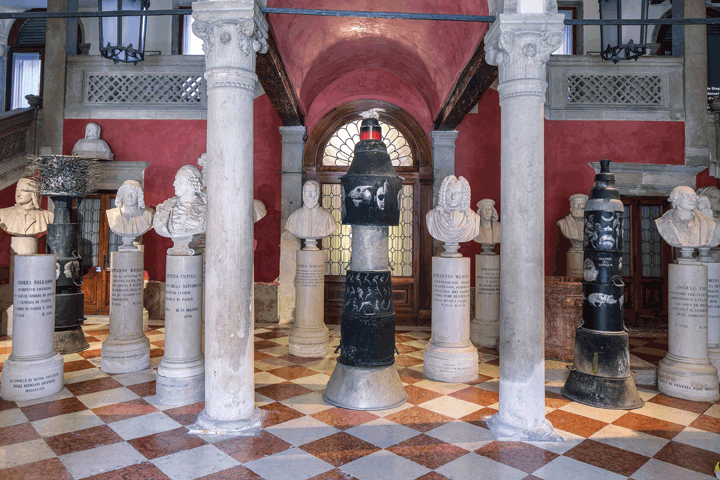
Roberto Fabelo, Memories, 2017, mixed media installation, drawing on metal pots, variable dimensions. Installation view at the Cuban Pavilion, 57th Venice Biennial.
By Paul Laster
Celebrated as a fine draughtsman from the very onset of his illustrious career in the early-1980s, Roberto Fabelo worked his way into other mediums one step at a time. Often discussed in the context of Old Masters, such as Hieronymus Bosch, Francisco de Goya and Honoré Daumier, the 68-year-old Cuban artist also has a lot in common with a number of modern and contemporary artists and their related art movements.
Perhaps inspired by the fabulous storytelling in novelist Gabriel García Márquez’s most famous book, One Hundred Years of Solitude, Fabelo has adopted a similar style of magical realism for his highly enchanting art. Fascinated by myths, dreams and fairy tales, the Havana-based artist employs both caricature and symbolism-in the form of animals, nudes and everyday objects-to convey his personal and social concerns. Creating hybrid creatures that confront good and evil, the beautiful and the grotesque, and what’s imaginary and what’s real, Fabelo creates a fantastic vision of life from a distinctive personal point of view.

Roberto Fabelo, Cafedral, 2003, aluminum coffee pots and mirrors, 86.6” x 78.7” x 78.7.” Installation view at the National Museum of Fine Arts (MNBA), Havana, Cuba. MNBA Collection. This piece was exhibited in 2017 at “Café IN,” Museum of European and Mediterranean Civilizations, Marseille, France. It was also exhibited at the festival “Artes de Cuba,” John F. Kennedy Center for the Performing Arts, Washington D.C. (May 8th to 20th, 2018)
One of his earliest sculptural pieces to gain popular attention was the mixed-media assemblage Pequeño teatro, from 1995. Assembled like a three-part religious icon from scraps of wood and a cigar box resting on a golden corbel, the central container is filled and topped with small, hand-carved and painted figurative sculptures, a pencil and a jar of buttons. Meanwhile, the two side panels are illustrated with a cast of carnivalesque characters, which are typical of Fabelo’s work. Narrative in nature, the piece appears to be a sort of surreal self-portrait, where James Ensor meets Joseph Cornell in Dante’s Inferno.

Roberto Fabelo, A Little of Myself, 1995, mixed media on wood, 60.6” x 172” x 1.2.” It was exhibited at Fabelo’s solo exhibition, National Museum of Fine Arts (MNBA), Havana, Cuba, 2003.
Similarly, A Little of Myself, from the same year, offers more than 200 mostly small-scale illustrations of figures and objects spread over the expansive space of eight door-like panels that come together to make a kind of Rauschenberg or Johnsian “combine,” which mixes painting with found and fabricated elements. In one of the self-portraits in the piece, Fabelo depicts himself as a devil with pointy ears, while in another he appears more introspective, with a rhinoceros-a recurring symbol in his work-sitting atop his head.

Roberto Fabelo, Untitled, 2007, From “Building,” series, mixed media, 21.7” x 7.5” x 13.8.” Collection of the artist.
A series of sculptural assemblages from 2007 titled Building also uses wood as the primary material, with stacks of equally cut boards and beams bound together and topped with rhinos, skulls and devils. Like Christo’s wrapped and bound objects, Fabelo’s Building pieces are enigmatic and profound. Another earlier series of porcelain, wood and metal sculptures-titled Black Plates, from 2002-dish up strange servings of objects for poetic consumption. These varied, meal-size scenarios include an elephant confronted by a hunter, a truncated doll’s arm with a tiny head protruding from its stump and a simulated pile of feces accompanied by a spoon.

Roberto Fabelo, The weight of the shit, 2007, mixed media, variable dimensions. Collection of the artist.
The fake feces makes a return appearance in the ironic 2007 piece The Weight of Shit, which displays a pile of poo and a spoon sitting on the plate of a vintage commercial scale, similar in type that an old fashion grocer would use. Related to the visual puns that Marcel Duchamp and Man Ray would employ in their readymade artworks, the piece also has an affinity to Piero Manzoni’s legendary canned Merda d’artista (Artist’s Shit), from 1961.
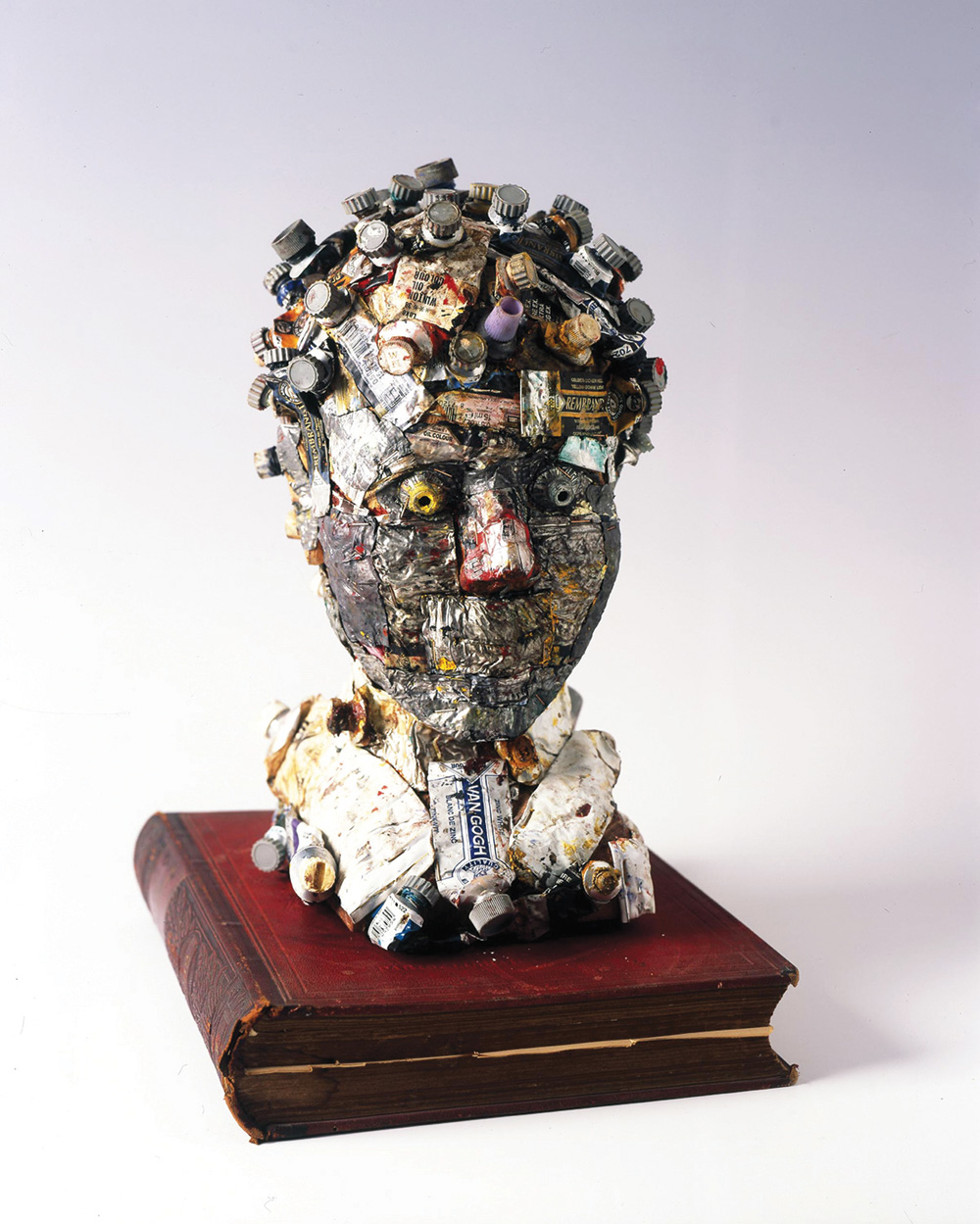
Roberto Fabelo, The Collector, 2008, mixed media, 15.7” x 10.2” x 12.6.” Fred Schrader Collection, California, USA.
Fabelo had previously toyed with these means of metaphoric word games and commodity fetishism when he built a cathedral shaped structure from coffee pots and mirrors, then amusingly titled it Cafedral, back in 2003. Likewise, the title of his 2007 hanging sculpture, Damn Trips, presents a play on words, with the piece portraying a giant, fabricated knife aggressively piercing two found suitcases, one black and the other tan.
Discarded coffee pots are back in play in his 2005 sculpture Home Sweet Home, which presents a still life arrangement of stacked, burnt coffee makers that have tiny figures hauntingly scratched out of and painted onto them-a technique the artist would investigate more thoroughly over time. But exploring the Nouveau Realist concept of accumulation deeper in that period, Fabelo cleverly constructed a human bust out of depleted tubes of paint, with the tops of the tubes shaping the eyes and hair and the flattened metal tubes forming the skin. The sly wit of the sculpture is increased by the visible brand names of the paints, including Rembrandt and Van Gogh, as well as by the use of a book for its base and his choice of The Collector as the title.

Roberto Fabelo, The Table, 2003, mixed media installation, variable dimensions. Installation view at the National Museum of Fine Arts, Havana, Cuba.
Emphasizing the serialism of his sculptures in his installations, Fabelo’s 2003 presentation of a giant table setting blew up the idea of consumption-as explored in Black Plates and Cafedral-to a scale on par with Claes Oldenburg’s monumental Pop Art pieces. This intriguing installation, titled The Table, places five gigantic plates with equally enormous utensils on the gallery floor. Empty, filled with bones and old pots, overturned and lined with a miniature model of Havana’s famous Malecón seawall, the plates become symbols for the hunger of the Cuban people, both for nourishment when supplies dwindled after the collapse of the Soviet Union and for anything new since the 1950s.
The issue of Cuba’s lacking of new things is evident in several more of the artist’s installations from the period. The 2006 floor piece, Island, comically captures the shape of the country’s landmass in an accumulation of castoff pots and pans, which Fabelo collected from restaurants and institutions. Meanwhile, the 2007 grouping, Towers, depicts five stacked totems with a shifting-scale of pots-both upright and inverted-that are topped by heads and incised and painted with self-portraits, female nudes and the proud Cuban flag.

Roberto Fabelo, Infinite Round, 2015, bronze and aluminum, variable dimensions. National Museum of Fine Arts Collection, Havana. It was exhibited at the 12th Havana Biennial, 2015; and at the festival “Artes de Cuba,” John F. Kennedy Center for the Performing Arts, Washington D.C. (May 8th to 20th, 2018)
The play of pots and pans continued in 2008 with a series of Volcano pieces, in which the discarded cooking objects were piled into a peaked mountain ready to erupt. Like the Indian contemporary artist Subodh Gupta, and recently deceased Emirati artist Hassan Sharif, Fabelo employed ordinary household objects to comment on consumerism, but while the former artists used new goods he chose to resurrect the worn and recycled to represent the characteristic Cuban way of life.
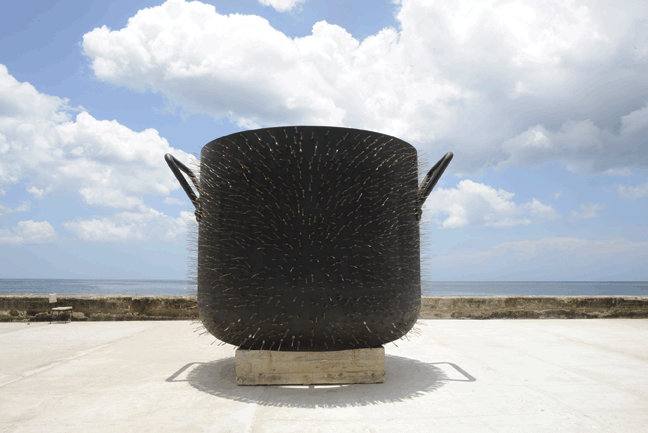
Roberto Fabelo, Delicatessen, 2015, steel, aluminum, variable dimensions. Installation view at Havana’s Malecon during the 12th Havana Biennial. Cuban Ministry of Culture Collection.
Two recent installations further involved pots at a Pop art scale. The 2015 sculpture Round consists of a giant pot displayed on a base. A legion of nude men, resembling the artist, walk around the upper edge of the pot while carrying forks at their shoulders, like soldiers with guns. The second piece, Fabelo’s public artwork Delicatessen, also from 2015, features a colossal pot stuck with hundreds of forks. It was exhibited on El Malecon, Havana’s famous boardwalk and most active outdoor space, during the 2015 Havana Biennial. Symbolic of both the hunger of the artist for life, sustenance and knowledge, as well as for the masses yearning for nutrition of all kinds, these large-scale installations shout subliminal messages, which are longing to be heard.

Roberto Fabelo, Worlds, 2005, mixed media, variable dimensions. Installation view at the National Museum of Fine Arts, Havana, Cuba. It was exhibited at the festival “Artes de Cuba,” John F. Kennedy Center for the Performing Arts, Washington D.C. (May 8th to 20th, 2018)
And two of Fabelo’s earlier installations employed methods of accumulation yet again. The 2005 work Worlds-consisting of five jumbo, globe-shaped forms covered in either spent bullet casings, animal bones, chunks of charcoal, silverware or cockroaches-is suspended from the gallery ceiling so that each particular realm floats in a parallel orbit. Survivors, meanwhile, presents a Kafkaesque group of huge cockroaches with human heads scaling the façade of Havana’s National Museum of Fine Art in 2009. Cockroaches, which are rumored to be robust enough to survive even an atomic blast, have been around since the beginning of time making them a good metaphor for the resilient nature of the Cuban people.

Roberto Fabelo, The Woman Who Loves Dogs, 2016, acrylic on embroidered silk, 65” x 48.” LA KOLE CCC Collection, Barcelona.
As previously discussed, Fabelo also draws on pots and pans-incising their blackened surfaces with a sharp tool, sketching on their dark exteriors with white crayons and painting on them like one would paint on paper or canvas. Illustrated on the bottoms of the grimy kitchenware, the first ones featured self-portraits of the artist with oversized flies on his head or insect antenna protruding from his forehead. Later ones expose such figures as running nude men and hybrid bird/men creatures circling the sides of the pots, while his 2017 installation Memories, which was exhibited in the Cuban Pavilion at the 57th Venice Biennale that year, serves as a sort of retrospective piece that combines a variety of his artistic styles in three totemic columns of stacked and altered pots, from which characters mysteriously seem to come to life in darkness.
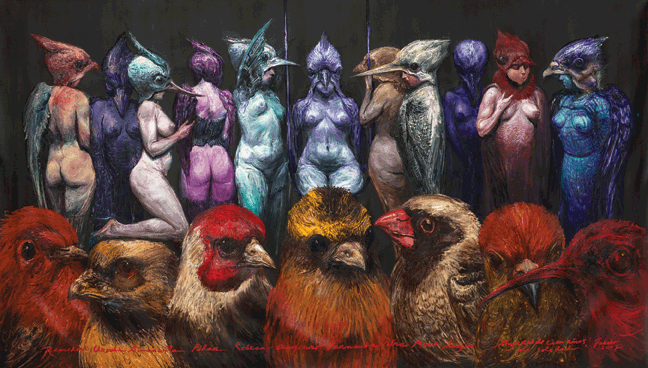
Roberto Fabelo, Mujeres de “Cien años de soledad,” 2008, oil on canvas, 65” x 110.” It was exhibited at “Fabelo’s Anatomy,” Museum of Latin American Art, Long Beach, California, 2014. Perez Art Museum Miami Collection.
Just as fascinating as Fabelo’s pots, are his new drawings on bookplates where he adds imagery over the text and to the illustrations, and his paintings on embroidered silk, which places the figure on a decorative ground. Following the Surrealist’s path, as well as one more recently traveled by contemporary artists like Tim Rollins and K.O.S., Fabelo has made nearly 100 drawings on the torn-out pages of anatomy books since 2013. Phantasmagorical in nature, they typically incorporate illustrations from the books, such as in Fold Head, which turns a drawing of a muscle into a sensual figure that’s part seductress and part bird, and Confusion Is Easily Committed, which magically pulls the likenesses of a femme fatale and a devilish king out of illustrations of skeletal hands.

Roberto Fabelo, My God, 2017, oil on canvas, 78.7” x 90.6.” It was exhibited at Roberto Fabelo’s solo show, Palazzo della Cancelleria, Rome, May 2017. Collection of the artist.
Continuing this series, the 2015 drawing Although Superficial turns a gash in a muscle into a buxom woman’s exposed vagina; the 2016 piece It’s Found Still fashions a pair of lungs into a woman’s hat, which spouts a pond where a man poetically sits in a boat; the 2017 sketch Our Face adds a man’s and a woman’s legs onto the facing hemispheres of a human brain; and Internal, also from 2017, slyly conjures a bearded, kneeling sage from an illustration of the peripheral nervous system. Somewhat like the imagery in Max Ernst’s famous collage novels, these figures are born from the existing illustrations, as if the artist was a witness to their making, as well as their creator.

Roberto Fabelo, Red Mermaid in the Little Theater, 2016, oil on canvas, 78.7” x 94.5.” Jimmy Ng. Collection, Singapore.
Working with oil on canvas-something he has done since attending the National School of Art in the late-1960s and early-‘70s-Fabelo has painted vivid allegories, with plump nudes cavorting midst the animal kingdom, as in the 1996 painting Big Red Lion and again the 2016 canvas Red Mermaid in the Little Theater. Yet flexible with styles and in content, he can tackle the grotesque at one moment, such as in his 2015 painting Ecstasy of the Fleeing Flesh, which presents the head of a fat figure with a protruding tongue who’s overrun by a herd of pigs, and convey the sublime in the next, as he does in his portrayal of an empty, broken pot floating in a clear blue sky in a 2017 canvas that’s ironically titled My God.

Roberto Fabelo, Ecstasy of the Fleeing Flesh, 2015, oil on canvas, 78.7” x 90.6.” It was exhibited at “Nuevos colores,” Robert Miller Gallery, New York, 2015. Mario José Hernández Collection.
Dating back to the early-2000s, Fabelo’s paintings on embroidered silk explore the representational subjects of his well-known canvases, watercolors, and bronzes in a completely different way. Similar to the effect that Sigmar Polke and Walter Robinson have gotten from painting on bed sheets, the ornamental surface provides a type of veil that distances the viewer from the subject, thus making it even more desirable. The floral patterns also add a level of opulence and elegance to Fabelo’s otherwise dreamlike and disconcerting imagery.
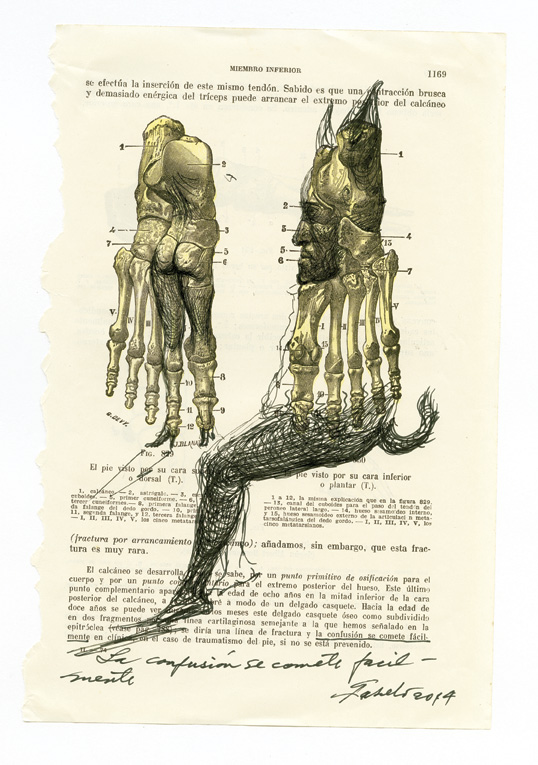
Roberto Fabelo, Confusion is Easily Committed, 2014, ink on printed paper, 10” x 6.” Perez Art Museum Miami Collection.
The 2012 painting Fantastic Voyage reveals a nude woman riding a rooster and wearing a bird’s head helmet, while 2014’s Three-Meat Skewer depicts three, high-heeled nude women-one that looks like an escargot, another that’s pig-like and the third that resembles a bird-sadistically pierced by a skewer and ready to be consumed. The following year, Fabelo made Meditation in Istanbul, which portrays the floating head of a voluptuous young woman, whose hair is made up of birds that are woven together like the figures found in M.C. Escher’s puzzling graphic pieces. In 2016 he made another version, Meditation, where the model’s head is nightmarishly covered with flies, as though they were attracted by her sweetness and want to take it from her-or perhaps it alludes to the presence of fears and insecurities.

Roberto Fabelo, Meditation, 2016, acrylic on embroidered silk, 66.1” x 48.” It was exhibited at Roberto Fabelo’s solo show, Palazzo della Cancelleria, Rome, May 2017. Mario José Hernández Collection.
In his 2016 painting The Woman Who Loved Dogs, a plump, nude, elderly woman, whose hair is laced with an array of dogs, sits seductively bound in straps, while in another painting on silk from that year, titled Romantic Rhinos, a young mermaid sleeps nestled on the ground as a group of miniature rhinoceros ramble across her back. And in his 2017 silk piece Dream Dough, Fabelo places one of his damsels in distress, that wears a shell for a hat, on a plate full of pasta-waiting to be devoured along with the interwoven noodles.

Roberto Fabelo, Three-meat Skewer, 2014, acrylic on embroidered silk, 93” x 52.” It was exhibited at “Fabelo’s Anatomy,” Museum of Latin American Art, Long Beach, California, 2014. LA KOLE CCC Collection, Barcelona.
Resembling scenes straight out of the black comedy films The Cook, The Thief, His Wife & Her Lover (directed by Peter Greenaway, in 1989) and Delicatessen (directed by Jeanne-Pierre Jeunet and Marc Caro, in 1991), Fabelo’s work embraces his concerns about erotism, desire, human relationships, culinary, nature, and ecology, as well as social issues. The pot is either full or empty. Your appetite is either voracious or your plate is clean. The disparities between the rich and the poor, between who has power and who doesn’t continue to impact the world as much as they influence this Cuban dreamer, who cleverly knows how to turn thought into art.
Paul Laster is a writer, editor, independent curator, artist, and lecturer. He is a New York desk editor at ArtAsiaPacific and a contributing editor at Whitehot Magazine of Contemporary Art and artBahrain. He is also a contributing writer to ARTPULSE, Time Out New York, Observer, Modern Painters, Cultured Magazine, Harper’s Bazaar Arabia, Galerie Magazine and Conceptual Fine Arts.




































Leave a Reply
You must be logged in to post a comment.